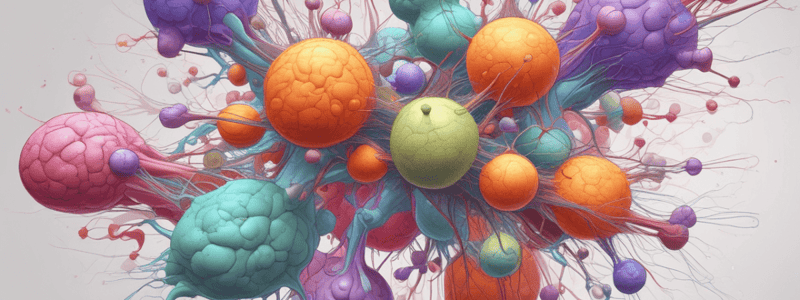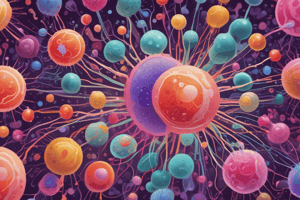Podcast
Questions and Answers
What is the main function of chemokines?
What is the main function of chemokines?
- Inducing cell migration (correct)
- Triggering signaling events
- Facilitating leukocyte traffic
- Regulating cell survival
Which family of chemokines is the most common?
Which family of chemokines is the most common?
- CX3C
- CC (correct)
- CXC
- C
How do cytokines regulate various cellular functions?
How do cytokines regulate various cellular functions?
- By promoting cell proliferation
- By inducing cell migration
- By triggering cell death immediately
- By binding to specific receptors on target cells (correct)
What do cytokines and chemokines act as in the immune system?
What do cytokines and chemokines act as in the immune system?
Which type of cells produce cytokines and chemokines in response to pathogens or abnormal cells?
Which type of cells produce cytokines and chemokines in response to pathogens or abnormal cells?
How do chemokines achieve their effects?
How do chemokines achieve their effects?
What is the role of chemokines in neuroinflammation and disease pathogenesis?
What is the role of chemokines in neuroinflammation and disease pathogenesis?
Which cytokines are the most important inflammatory mediators in Osteoarthritis (OA)?
Which cytokines are the most important inflammatory mediators in Osteoarthritis (OA)?
What can dysregulation of cytokines and chemokines lead to?
What can dysregulation of cytokines and chemokines lead to?
How do chemokines contribute to the progression of Osteoarthritis (OA)?
How do chemokines contribute to the progression of Osteoarthritis (OA)?
What is the key function of CCR receptors?
What is the key function of CCR receptors?
Which signaling pathways are activated by proinflammatory cytokines in Osteoarthritis (OA)?
Which signaling pathways are activated by proinflammatory cytokines in Osteoarthritis (OA)?
Flashcards are hidden until you start studying
Study Notes
Cytokines and Chemokines: The Crossroads of Immune Responses and Disease Pathogenesis
Cytokines and chemokines are small proteins that act as signaling molecules at picomolar or nanomolar concentrations to regulate immune responses throughout the body. They play a crucial role in maintaining immune surveillance, facilitating leukocyte traffic, and recruiting other inflammatory factors. These molecules are involved in the regulation of CNS-immune system interactions and are produced not only by white blood cells but also by various other cells in response to pathogens or abnormal cells.
Cytokines
Cytokines are a diverse group of pro- or anti-inflammatory factors that are involved in regulating cell survival, differentiation, and activation. They function by binding to specific receptors on the surface of target cells, triggering a cascade of signaling events that regulate various cellular functions such as cell adhesion, phagocytosis, cytokine secretion, cell activation, cell proliferation, cell survival, and cell death.
Chemokines
Chemokines belong to the family of cytokines and are involved in the induction of cell migration. They are classified into four families based on the positioning of the N-terminal cysteine residue: CC, CXC, C, and CX3C. The most common chemokines belong to the CC and CXC families. These small proteins (8–12 kDa) achieve their effects by binding to G-protein coupled cell-surface receptors. CCR receptors bind only CCL chemokine ligands, while CXCR receptors bind CXCL ligands[144].
Cytokines and Chemokines in Neuroinflammation and Disease Pathogenesis
In the context of neuroinflammation, cytokines and chemokines play a significant role in the development of neurodegenerative diseases such as bacterial Lyme neuroborreliosis, human immunodeficiency virus encephalitis, and neuropathic pain. They can affect neuroinflammation and disease pathogenesis by inducing cell migration, mediating neuronal and glial cell injury and death, and perpetuating inflammation through a feedback loop.
Cytokines and Chemokines in Osteoarthritis Pathogenesis
Osteoarthritis (OA) is a common musculoskeletal condition that affects all joint tissues, including cartilage, bone, and connective tissue. A disturbed cytokine balance in favor of proinflammatory cytokines is a well-established factor in the pathogenesis of OA. The most important inflammatory mediators in OA are IL-1β, TNF-α, and IL-6, which activate a variety of signaling pathways and promote the secretion of inflammatory factors. Chemokines, stimulated by cytokines, attract inflammatory cells to the joint, further promoting inflammation and disease progression.
In summary, cytokines and chemokines are essential for regulating immune responses and maintaining immune surveillance in the body. Their dysregulation can lead to pathological states, such as neuroinflammation and OA, which can exacerbate disease progression. Understanding the role and mechanisms of these molecules can provide insights into potential therapeutic targets for various diseases.
Studying That Suits You
Use AI to generate personalized quizzes and flashcards to suit your learning preferences.




